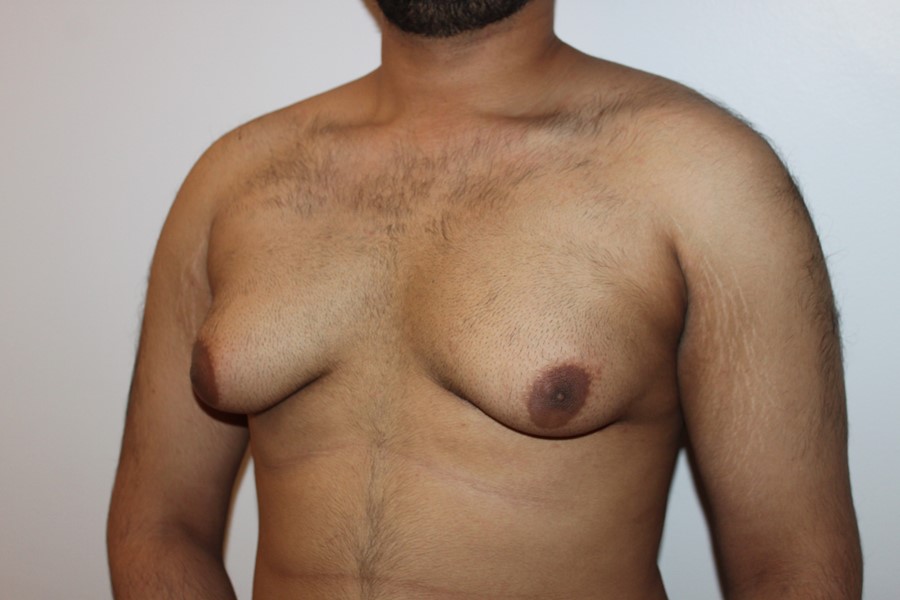Who has them, what causes them, and how to get rid of them (if you want to)
From the individuals extracting earwax from your eardrum to the quiet crusaders shaving skin off your feet, in our regular series The Professionals we meet the people taking pride in the nitty-gritty side of beauty.
Gynaecomastia – or “moobs” as the press has unceremoniously christened it – is a very common condition that to varying degrees affects upwards of 40 per cent of the male population. Despite what many people believe, gynaecomastia actually doesn’t stem from high levels of female hormones but rather receptors in the cells of the chest area that are more sensitive to the circulating female hormones, something which is largely genetically determined.
While not all those who have gynaecomastia want to receive treatment, for some the physical and psychological effects of the condition lead them to seek out medical help. “From a psychological point of view, it can affect your confidence and self-esteem considerably,” says Dr Alex Karidis, the UK’s leading gynaecomastia surgeon.
“It affects relationships, people’s ability to do things such as going swimming since it can make you feel self-conscious. When you are restricted in anything in life this can impact your psyche as well. It can be a very serious issue for many people.”
Here, Dr Karidis cuts through all the misconceptions and misinformation that surrounds gynaecomastia to tell you everything you need to know about the condition.
What causes gynaecomastia?
Alex Karidis: It is largely hereditary, or so-called idiopathic meaning there is no specific reason for it or reason that we know. Occasionally, of course, medications can cause this – such as anabolic steroids. Sure, genetics do play a role, as we all have a certain shape to us. Whether we carry fat on our thighs, our hips, our waist or on our chest these are all determined genetically.
There are things which can improve our shape through various means of exercising, but there are also some shapes that are resistant to exercise and diet. Gynaecomastia involves glandular tissue meaning breast tissue, so it is not just fat that you are trying to reduce when you look at large breasts on a man. So you cannot change this simply through exercise and diet alone. With exercise and diet, you can lose the fatty element of the issue, but it doesn’t get rid of the glandular or breast tissue element because it is a combined dual-element problem.
For instance, if you have got fat on your stomach, that is just fat, but in the breast area there is breast tissue as well so in fact when you do lose weight and you have a gynaecomastia problem you then expose the breast element even more. This is because the fat that is surrounding the breast tissue sometimes hides it all but when you lose the fatty component then the breast becomes more prominent so it can actually make the problem worse.
What happens during gynecomastia surgery? How does it actually work?
Alex Karidis: The idea is to remove both the breast tissue and the fat, the problematic elements that are causing the projection and the fullness in the area. We also then have to look at the skin. If you have good quality skin, meaning good collagen and good elastin within the skin, it then has the ability to contract, shrink and spring back when you remove the fatty and glandular elements. However, if someone has very saggy skin, due to perhaps big weight gains and losses, then the problem is that there is occasionally the need to take up some of the skin. But that is a very small minority of patients who require this.
The procedure is minimally invasive, meaning an incision of less than one centimetre is made on the nipple at around six o’clock, where the areola is and where the brown or darker skin meets the lighter skin. Another incision of around half a centimetre is also made in the armpit. We then go in and we use a combination of liposuction and then gland removal to basically remove the offending elements but at the same time sculpt the area into something that looks more like a chiselled chest.
How long does it take to recover?
Alex Karidis: Most people will go back to office work within three to four days. You will have to wear a special compression vest for approximately two weeks and which we supply, but technically you can return to an office job within three to four days. It’s not particularly painful, but we do provide our patients with painkillers so it is reasonably manageable. Most will go back to the gym at around three weeks. It is a really quick recovery overall.
What are the most common misconceptions about gynaecomastia?
Alex Karidis: That you have too many female hormones, it’s not. The hormone levels in people with gynaecomastia, no matter what the degree of gynaecomastia is, usually by and large are normal. We all have both male and female hormones in our body. In men we have more of the male type hormones than the female hormones. It’s just that people who do have gynaecomastia have more receptors in the cells in the chest area which are a bit more sensitive to the circulating female hormones, so they pick up on those more than they would normally. This then leads to more prominent gland formation in those patients. All that is purely determined genetically, and through family history and that’s why there is a difference.
What qualifications does one need to be a gynaecomastia surgeon?
Alex Karidis: First and foremost, you have to be a surgeon, a qualified surgeon, that is important. Unfortunately in the UK, you don’t have to be a qualified surgeon to operate on somebody, so be aware! As long as you have a medical degree you can technically operate on anyone. It is important, however, that one does have a surgical qualification to perform this type of surgery. There are some breast surgeons who do it, they are surgeons who specialise in female breast procedures but who can also accommodate male breast procedures and of course, plastic surgeons are the other professionals who carry out this surgery.
What are the most challenging parts of your profession?
Alex Karidis: The most challenging part of my profession is meeting patient’s expectations, unquestionably. That is the hardest part of my job. Everyone has a different idea in their mind about what they want to achieve and whether it is achievable or not will be discussed. The goalposts can change considerably and many people come in with a thought of what they will look like and then after the operation it looks a little bit different.
The goalposts can then move again in terms of whether they are satisfied or not. I always tell trainee surgeons that you can be god’s gift to surgery and you can be the most talented surgeon on the planet but you are still going to get perhaps 10-15 per cent of people that are disappointed or unhappy with the outcome of your work. And it's not because the surgery was substandard, but just that the expectations of the patient weren’t managed very well. It is nearly impossible to meet every single person’s expectations.
What are the most rewarding parts? What is it you enjoy about doing it?
Alex Karidis: Being able to change something that is a problem for patients and by being able to take the weight off of their shoulders which has been a problem for many, many years is really refreshing and rewarding. You have the ability to make a difference to the patient who often walks in with a different attitude, different mentality and that is where I get my satisfaction from.
As the procedure is done minimally invasively without large scars, it largely relies on feel and vision to basically get the right result. And this is down to the experience of the surgeon. It is like asking a sculptor ‘when do you stop your statue’ and they’ll say when it looks right. It is the same for us as well, we stop when it looks right and as I said this is purely down to the surgeon's expertise. It is a bit of an art form I guess.
Are there alternatives treatments or procedures?
Alex Karidis: Unfortunately, there are not. There are no creams, tablets or ointments I can give to patients that simply eradicate the problem. There are only two options, either living with the issue and being able to accept it or if that isn’t possible, surgery is the only other available option. Having said that, people can try compression by wearing tight lycra underneath their shirts to strap themselves down but that isn’t really a solution to the problem, more hiding the effect.
Are there any advancements coming in the field? What does the future look like?
Alex Karidis: We are keeping an eye out all of the time but I haven’t seen any massive shifts in terms of game-changers. Complications such as infection, bleeding and surface irregularities have been reduced, and that’s gone a long way towards improving the procedure. But the single most important aspect that determines the success of this operation is the surgeon with the aid of technology and technique.




